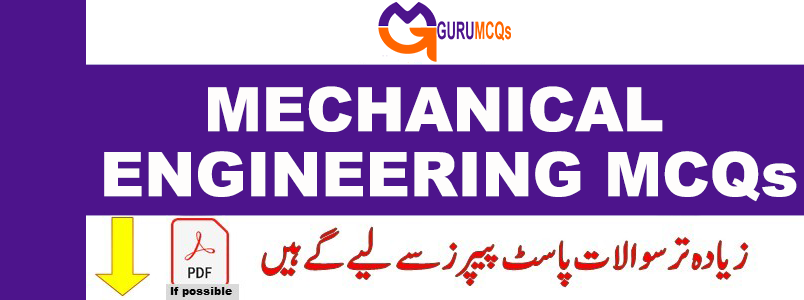
GuruMCQs.com provides all updated Mechanical Engineering Multiple Choice Questions (MCQs). The most frequently repeated mechanical MCQs section is frequently encountered in FPSC, PPSC, ETEA, NTS, Army, Navy, Air Force, educators, and various other competitive exams, as well as government and private job assessments. Most repeated mechanical engineering MCQs cover topics like Engineering Materials, Fluid Mechanics, Hydraulic Machines, Machine Design, Engineering Mechanics, Nuclear Power Plants, Steam Boilers, Engines, Nozzles, Turbines, Compressors, Gas Turbines, Jet Engines, Thermodynamics, Engineering Metrology, Heat Transfer, etc. Preparing with these MCQs can significantly contribute to your success in government job exams and interviews. Whether you are aiming to establish a career in engineering or seeking to enhance your existing skills, the Mechanical Engineering MCQs at www.gurumcqs.com serve as a valuable resource. Stay committed to regular practice and empower yourself with the knowledge needed to excel in your academic and professional endeavors.
**131. The primary function of the compressor in a refrigeration system is to:**
– A. Increase the pressure of the refrigerant
– B. Decrease the pressure of the refrigerant
– C. Change the state of the refrigerant from liquid to vapor
– D. Change the state of the refrigerant from vapor to liquid
**132. Which of the following refrigerants has the lowest ozone depletion potential (ODP)?**
– A. R-12
– B. R-22
– C. R-134a
– D. R-410A
**133. In a refrigeration system, the evaporator functions to:**
– A. Increase the pressure of the refrigerant
– B. Decrease the pressure of the refrigerant
– C. Reject heat to the surroundings
– D. Absorb heat from the surroundings
**134. The coefficient of performance (COP) of a refrigeration system is defined as:**
– A. The ratio of heat rejected to the surroundings to the work input
– B. The ratio of work input to the heat absorbed from the surroundings
– C. The ratio of heat absorbed from the surroundings to the work input
– D. The ratio of heat rejected to the surroundings to the heat absorbed from the surroundings
**135. In a refrigeration cycle, the throttling process occurs at the:**
– A. Condenser
– B. Evaporator
– C. Compressor
– D. Expansion valve
**136. The process of subcooling in a refrigeration cycle involves:**
– A. Cooling the refrigerant below its condensing temperature
– B. Heating the refrigerant above its condensing temperature
– C. Expanding the refrigerant in the expansion valve
– D. Increasing the pressure of the refrigerant in the condenser
**137. The primary function of the expansion valve in a refrigeration system is to:**
– A. Increase the pressure of the refrigerant
– B. Decrease the pressure of the refrigerant
– C. Control the flow rate of the refrigerant into the evaporator
– D. Control the temperature of the refrigerant leaving the condenser
**138. The evaporator fan in a refrigeration system is responsible for:**
– A. Increasing the pressure of the refrigerant
– B. Decreasing the pressure of the refrigerant
– C. Circulating air over the evaporator coils
– D. Circulating refrigerant through the system
**139. Which of the following statements about the Carnot refrigeration cycle is true?**
– A. It operates without any irreversible processes
– B. It has a lower coefficient of performance compared to practical refrigeration cycles
– C. It requires a compressor to operate
– D. It cannot achieve temperatures below the ambient temperature
**140. The condenser in a refrigeration system functions to:**
– A. Increase the pressure of the refrigerant
– B. Decrease the pressure of the refrigerant
– C. Reject heat to the surroundings
– D. Absorb heat from the surroundings
